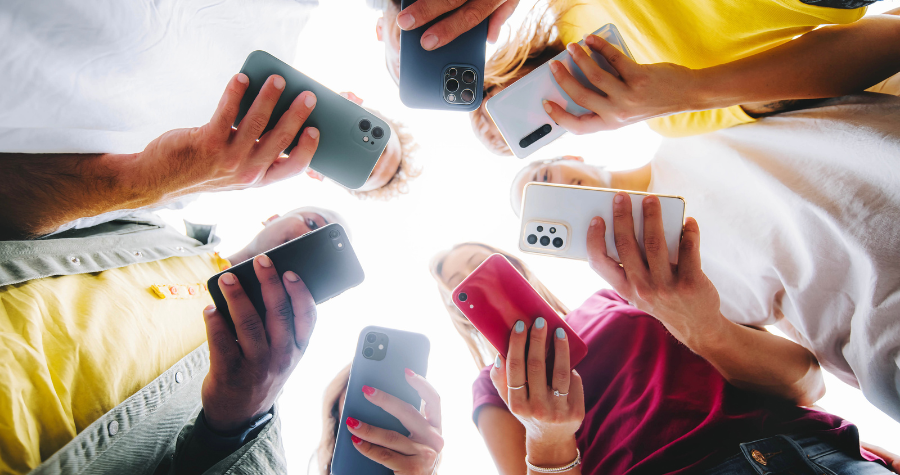Rising social media platforms every marketer should know about

It’s no secret that social media makes our modern world go round.
On average, people spend 2 hours and 23 minutes a day on social media. That’s just over 36 days a year.
And, that number will only continue to grow as social media platforms rise in popularity.
Globally, the number of social media users has grown from 4.72 billion in January 2023, to 5.04 billion in January 2024 - that’s a whopping 8% of year-on-year growth, equating to 320 million more users!
But, this growth isn’t evenly spread amongst platforms.
Whilst Facebook, YouTube and Instagram are the most popular social media sites, they see slower growth in comparison to newer platforms that are gaining popularity.
However, despite the smaller growth, older platforms such as these remain as popular as ever, with 94.2% of today’s internet users having a social media identity.
Exploring what’s currently trending on social media is one of the best ways to refresh your marketing strategy to keep appealing and engaging your audience.
That’s why we’re always on the pulse of the next big trend, translating and adapting it for that big B2B impact. It’s about reshaping and interpreting trends through a product media lens.
Are you ready to get trending?
How has social media changed over the years?
Let’s take things back to the beginning: MySpace.
Many millennials can remember their first MySpace account. The hours spent curating their profiles, connecting with friends, and listening to the latest songs. In 2004, MySpace was the first social media site to reach a million monthly active users.
It was the birth of social media as we know it.
But social media has come a long way in the last 20 years. Whilst MySpace was championed for its authenticity, the rise of AI and influencer culture has redefined what it means to exist online.
On top of this, whilst social media sites continue to push a never-ending stream of quick-moving content to our screens, our attention spans are shortening, and the way we consume media is changing.
Essentially, social media platforms today are shape-shifters, constantly evolving to stay at the forefront of users' minds.
The rise of AI
AI is a buzzword at the moment. Sites such as ChatGPT are helping AI become more accessible, driving a surge in discussions about artificial intelligence. However, trust in AI remains low, despite these growing conversations.
Social media sites have been leveraging artificial intelligence technologies for years. News feeds and timelines are not chronologically displayed - instead, social media sites use AI to order posts based on what they think you want to see.
AI facial recognition software is also built into the fabric of social media. It is used to help recognise facial structures to identify users or overlay edited filters on images.
However, more recently, generative AI has been used to create text, imagery and hashtags for social media accounts, sparking criticism from other users. People are calling for more transparency, more authenticity, and more originality in the media they consume.
However, despite these criticisms, the AI market in social media is expected to reach $3,714.89 million by 2026.
Read more: Every Major Craze of the Last 100 Years
The growing influencer market
According to 60% of marketers, influencer posts consistently outperform branded posts, making influencers the backbone of many social media campaigns. By providing seemingly authentic content to their loyal following, influencers have become one of the most effective marketing tools of the decade.
It’s unsurprising, then, to discover that the influencing market was worth 21.1 billion dollars in 2023 - more than double what it was worth in 2019. In fact, 84% of marketers predict that most companies will have a creator or influencer as the face of their brand in 2024.
However, as the influencer market becomes more saturated, content creators have to become increasingly more innovative to capture the attention of their followers. This shift has turned the authenticity of influencer marketing on its head, with creators producing increasingly staged content to match briefs provided to them by brands.
And, whilst you would expect this turn away from natural content to negatively affect an influencer's following, we’re actually seeing the opposite.
In fact, in recent years we’ve seen the rise of virtual influencers such as Shudu Gram, the world’s first digital supermodel, and Lil Miquela, a 21-year-old robot who lives in LA, proving popularity isn’t directly correlated with authenticity.
So, whilst influencing certainly seems here to stay, it certainly isn’t stagnant. How creators fight to be at the top of your feed is constantly changing, and the influencer market will only become more complex from here.
Shortening attention spans
How we consume content on social media is changing. Where early sites such as MySpace & Facebook were predominantly text-based, it seems that in recent years visual platforms such as TikTok and Instagram are the most popular.
However, this shift to image-based content comes with its own unique set of challenges. Our passive consumption of short-form, endlessly accessible content such as TikToks, Instagram Reels & YouTube Shorts, have essentially caused our brains to be unable to focus on longer videos or material.-Oct-21-2024-09-50-01-8511-AM.png?width=600&height=300&name=blog%20images%20(1)-Oct-21-2024-09-50-01-8511-AM.png)
This raises concerns for younger generations of social media users. According to research conducted by the Pew Research Centre, 31% of teens said they lost focus in class because they were checking their mobile phones, and 49% said using technology for reasons unrelated to class was distracting them. On top of this, research conducted by Microsoft suggests that we have a shorter attention span than goldfish, which is less than 9 seconds.
However, whilst there’s still plenty of reason for concern, professionals say that the inattention epidemic is one we have the power to reverse. We’re not losing the ability to focus, we’re just constantly in an environment where we can be distracted.
Having social media nowadays is like trying to complete a task in a crowded room where people are constantly talking to you and really loud music is playing. It’s no wonder we’re struggling to concentrate!
Read more: How to engage your Gen Z new starters.webp?width=600&height=267&name=email%20banners%202023%20(13).webp)
How has how people use social media changed?
Introducing social shopping
We’ve seen a distinct rise in social shopping over the past few years. Platforms such as TikTok provide e-commerce options in-app, whilst Instagram allows users to post affiliate shopping links in their stories. As a result, 84% of social marketers say consumers will buy products in social apps more often than on brands’ websites, or third-party websites like Amazon in 2024.
Despite TikTok Shop only being launched in September 2023, it is now the second-most likely app for consumers to have purchased on in the last 3 months.
Nearly 47% of US consumers make purchases on social media, making it one of the most effective ways to drive sales.
Social media’s search engine takeover
Amongst younger generations, social media has become a substitute for a Google search.
36% of Gen Z and 22% of Millenials prefer to search for brands on social media, thanks to the personalised and relevant content it provides.
What’s more, social media combines branded results with content generated by other users, meaning that they’re likely to see brand reviews or first-hand experiences within their search. This is more appealing than the traditional search engine, as it provides users with a more comprehensive overview of their chosen brand, with less effort. -Oct-21-2024-09-55-32-2358-AM.png?width=600&height=300&name=blog%20images%20(2)-Oct-21-2024-09-55-32-2358-AM.png)
However, whilst social search and AI shake up traditional search engines, people still trust them. Google still owns 81.5% of the market share, so social search has a long way to go if it wants to compete with it long-term.
Who uses what social media platforms?
Facebook, YouTube & Instagram remain the most popular social media apps, having established their popularity for well over the last decade.
However, since 2023, Lemon8 (+200%), Tumblr (+20%) & TikTok (+9%) have seen the biggest growth, alongside BeReal (+333%) and Twitch (+43%).
Specifically, the number of Boomers using TikTok grew by 60% in the last year, whilst Gen X grew by 12%, showing that they’re catching on to many Gen Z trends & apps.
On the other hand, Reddit (-28%), X/Twitter (-23%) and LinkedIn (-22%) have seen the greatest decline in usage over the last few years.
What social content does Gen Z love?
Whilst Facebook is the most popular social media platform for people over 28, it’s no surprise that Gen Z’s favourite platform is TikTok.
The reason for this is simple: the rise of the short-form video.
The short-form video has stolen the show over the last few years, with people of all ages citing that it’s the form of content they enjoy the most. It provides snackable, addictive content for viewers, leading to higher levels of engagement than other forms of content. In fact, TikTok has the highest engagement rate out of any other social media platform, averaging 55.8 minutes per session.
Read more: Why are plants so popular with Gen Z?
How can utilising these social media platforms in your marketing strategy help your brand?
Social media is one of the most effective marketing tools of the decade. By meeting consumers in the digital spaces they naturally inhabit, you’re more likely to engage with people who are genuinely interested in the product or service you provide.
And, when you’re reaching audiences who are interested in your brand, you can have more authentic interactions that will in turn help you convert more social media users into customers.
Utilise user-generated content for authenticity
People love authentic and relatable content - so having a people-first social media strategy is key. 82% of Gen Z consumers would trust a company more if it used images of real customers in its advertising, so it’s important your content reflects the authentic, lived experiences of your customers.
User-generated content is a great way to inject some of this authenticity into your social media strategy. To do this, you can target nano or micro-influencers with their small but mighty audiences. With up to 7x more Instagram engagement than mega-influencers, these creators are generally great for helping to humanise your brand to niche audiences. Smaller, less experienced creators, they’re often more budget-friendly, too!
Tap into trending forms of content
As we mentioned earlier, the short-form video is trending.
Social media marketers say short-form videos have some of the highest ROI this year, especially when posted on TikTok. However, TikTok isn’t the only home for this type of content: YouTube, Instagram and Facebook all have separate feeds solely focusing on videos. 24% of social media marketers plan to invest the most in Instagram over any other platform, showing the importance of diversifying your visual content.
Read more: The most popular promotional merchandise trend of the year: branded little luxuries 
Build your online community
To put it simply: online communities put the ‘social’ in ‘social media’.
A strong online community can help your brand connect your prospects and customers, ultimately providing them with more value, and more reason to invest in your product or service.
48% of marketers list Facebook as the most effective platform for building an active community, closely followed by YouTube (46%) and Instagram (40%).
Read more: 10 easy hacks for building brand awareness
Rising social media platforms every marketer should know about
Want to get a leg-up on your competitors on socials? Want to explore new and untapped audiences online? Or do you feel your brand could benefit from a different social media platform? Here are 5 rising social media platforms that every marketer should have on their radar for optimising their brand’s reach online.
1. BeReal
This is a platform that your brand needs to get on to appeal to Gen Z’s love of authenticity. Gone are the days of Instagram’s curated content, of Snapchat’s extortionate amount of filters. BeReal is all about being real (see what they did there?).
This is something your brand can use to its advantage to show off its more human self. There’s been an increase of 312% in BeReal downloads since its launch in 2019, and it’s been downloaded approximately 30 million times.
2. Lemon 8
If you love TikTok, Pinterest and Instagram, this app is for you! It’s a place to share videos and photos, but utilising Pinterest board-styles. It’s all about lifestyle and aesthetics over on Lemon8, so if you’re an interior or lifestyle brand, this is the app for you.-2.png?width=600&height=300&name=blog%20images%20(3)-2.png)
3. Vero
Vero is unique in that there are no algorithms, it’s 100% ad-free and there’s zero data mining. Sounds too good to be true, right? But, the reason for all this is that the founders wanted the platform to be ‘more social, less media’. It’s a growing platform of 4.5 million followers so far.
This is dubbed as being the future of social media, and if your brand can get on it now, you’ll be leaps ahead of your competitors.
4. Discord
If you’ve got a gamer in your life, you’ve probably heard of Discord. However, the platform isn’t just for gamers anymore. As a chat-focused social media platform, they are a leader in the sphere, with 522 million visitors in 2022 and a $995 million in funding.
This is a new content platform where you’ll have to rethink what content you’re putting out, but if you think chat-based, video content sits within your brand, then it’s definitely one to take a look at.
5. Hive Social
This one’s still a bit of a mystery. We only know that it was founded by someone calling themselves ‘Raluca’ in 2019 who was fed up with not seeing posts by her friends on traditional social media platforms. It’s like X (formerly Twitter), where it’s mainly text-based and users can like and repost what their friends have shared.
However, what sets it apart from X is that its feed is chronological and there are no character limits. Profiles can be personalised a lot more, too.
If you’re looking for somewhere to be heard above all the noise, this is it.
The OG social network: promotional merchandise
We love new social media platforms as much as the next person (Threads, anyone?), but nothing truly beats promotional merchandise for that tangible brand impact. Did you know, 87% of people given a free promotional gift hang onto it for 12 months or more? We can help you utilise the power of merch for your brand and help you bridge the gap between the virtual and the physical.
Because, even if your social media is epic, it’s not 87% epic.

